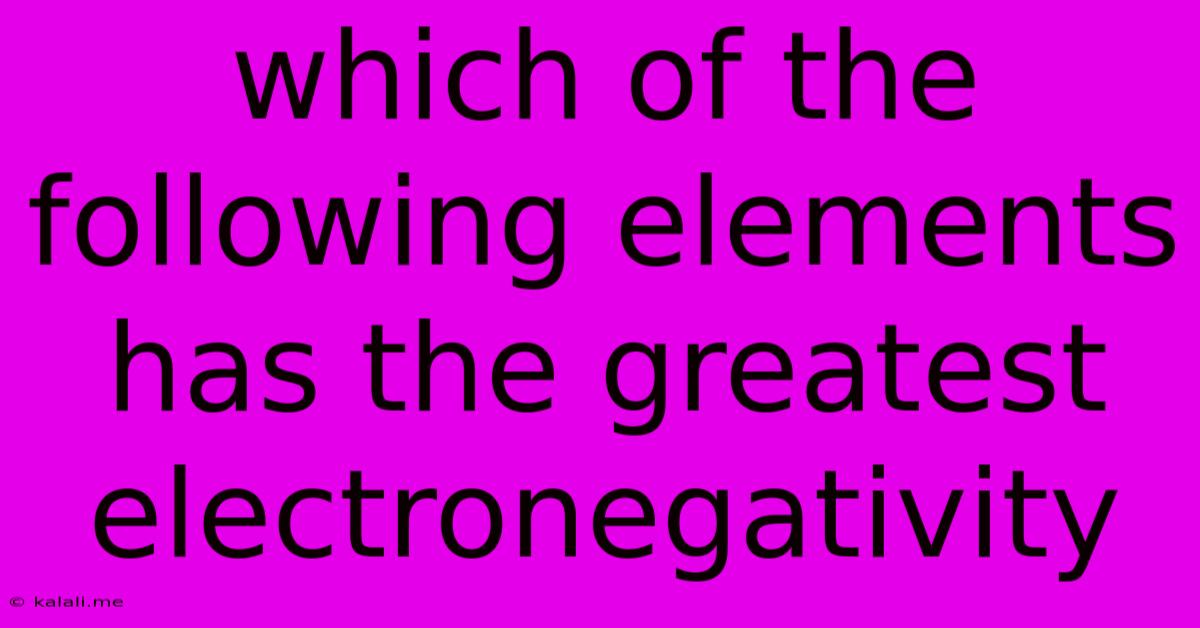Which Of The Following Elements Has The Greatest Electronegativity
Kalali
Jun 13, 2025 · 3 min read

Table of Contents
Which Element Boasts the Highest Electronegativity? Understanding Electronegativity Trends
Electronegativity, a fundamental concept in chemistry, describes an atom's ability to attract electrons within a chemical bond. Understanding electronegativity is crucial for predicting the nature of chemical bonds (ionic, covalent, polar covalent) and the properties of molecules. This article will explore which element holds the title of the highest electronegativity and the trends that govern this property within the periodic table.
What is Electronegativity?
Electronegativity reflects how strongly an atom attracts bonding electrons to itself. A higher electronegativity value indicates a stronger pull on electrons. This difference in electronegativity between atoms in a bond influences the bond's polarity. A large difference leads to ionic bonds, while a smaller difference results in polar covalent bonds, and a negligible difference leads to nonpolar covalent bonds. Several scales exist to quantify electronegativity, the most common being the Pauling scale.
Periodic Trends in Electronegativity:
Electronegativity isn't a directly measurable quantity like mass or charge, but it follows predictable trends across the periodic table:
-
Increases across a period (left to right): As you move across a period, the number of protons in the nucleus increases, while the additional electrons are added to the same shell. This increased nuclear charge pulls the electrons closer, enhancing the atom's ability to attract electrons in a bond.
-
Decreases down a group (top to bottom): Moving down a group, electrons occupy higher energy levels, further from the nucleus. The increased distance shields the outer electrons from the nuclear charge, weakening the attraction. The larger atomic size also contributes to decreased electronegativity.
The Element with the Highest Electronegativity:
Based on the Pauling scale, fluorine (F) possesses the highest electronegativity value. Its small atomic size and high effective nuclear charge result in a strong pull on bonding electrons. This makes fluorine highly reactive and prone to forming strong bonds.
Other Highly Electronegative Elements:
While fluorine takes the top spot, other elements exhibit high electronegativity values. These elements are generally located in the upper right corner of the periodic table, reflecting the established trends. Oxygen (O), nitrogen (N), and chlorine (Cl) are examples of highly electronegative elements, though significantly less so than fluorine.
Understanding the Implications of Electronegativity:
The electronegativity of an element significantly influences its chemical behavior and the properties of the compounds it forms. This includes:
- Bond polarity: The difference in electronegativity between atoms determines the polarity of a chemical bond.
- Molecular polarity: The overall polarity of a molecule is influenced by the polarity of individual bonds and the molecule's geometry.
- Chemical reactivity: Highly electronegative elements tend to be more reactive, readily participating in chemical reactions to achieve stable electron configurations.
- Acid-base behavior: Electronegativity plays a role in determining the acidity and basicity of compounds.
Conclusion:
In summary, fluorine (F) holds the distinction of having the highest electronegativity among all elements. This property stems from its unique atomic structure and position within the periodic table. Understanding electronegativity trends is vital for predicting the behavior of atoms and molecules and interpreting their chemical properties. The concept of electronegativity is fundamental to understanding a wide range of chemical phenomena.
Latest Posts
Latest Posts
-
Which Answer Choice Correctly Defines Plot
Jun 14, 2025
-
A Biological Community Of Interacting Organisms And Their Physical Environment
Jun 14, 2025
-
Least Common Multiple Of 14 And 49
Jun 14, 2025
-
Which Of The Following Is A Natural Polymer
Jun 14, 2025
-
Which Elements On The Periodic Table Are The Least Reactive
Jun 14, 2025
Related Post
Thank you for visiting our website which covers about Which Of The Following Elements Has The Greatest Electronegativity . We hope the information provided has been useful to you. Feel free to contact us if you have any questions or need further assistance. See you next time and don't miss to bookmark.